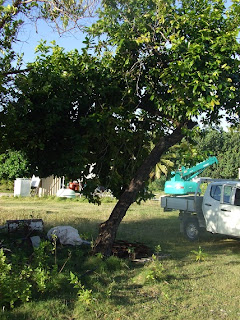Grahams' garden was a fairly recent creation although you didn't get that impression because it was so shady and protected.
We were told that each tree was planted with a bale of hay beneath it to compensate for the lack of organic matter in the soil. He established significant windbreaks which has cut down on salt spray , wind and rain from coming onto the verandah. The windbreaks have also no doubt made a big difference to what can be grown here easily.
There were numerous fruit trees planted amongst the ornamaental plants in the garden but as many of these plants were planted at more or less the same time, the fruit trees have had a chance to compete and were doing quite well.
On the vegetable front, Graham had gone to some effort to put in a hydroponic set up that was covered in shade cloth to keep the caterpillars at bay. His Tomatoes (Climbing Romas and Grosse lisse) looked very healthy and were just getting around to setting fruit - all of which were painstakingly hand pollinated. This is probably necessary because there was very little wind penetrating the shade house and wind is needed to dislodge the pollen in the tomato flower to achieve pollination. There was also Rocket and Lettuce growing quite happily although the lettuce was now going to seed.
In the past Graham had problems with mildew on his tomatoes after extended rainy periods. One suggestion to help solve this problem was roofing the shade house in polycarbonate transparent sheets to protect it from rain. Hydroponics don't need rain after all.
The hydroponic set up was run on rainwater caught from the roof of the house.
There were also some Tomato plants that he had planted outside in pots and they were doing very well thank you very much.
There was one banana tree in a box full of organic matter but, the plant wasn’t over the moon about the conditions – there may have still been some heat and rotting going on in the lower parts of the box. It was at Grahams house that i saw the first decent Mulberries- the trees were perhaps 10 feet tall and fruiting, although not heavily (In the tropics you get a springs crop of fruit and an Autumn crop). Another recently established tree was Breadfruit which was 10 feet tall (18 months old) had already produced some fruit. He was also growing Jambo which was common in the gardens of Home island. Amongst the ornamental plants were some stunning Gingers and Heliconias.
 |
| Purple King beans in recycled timber box |
In another part of his yard he was growing Purple King climbing beans which although not stunningly healthy were still producing some fruit and seeds. They has been planted into boxes that he had constructed out of used palettes that had been lined with some other waste plastic to reduce the effects of rotting on the woodwork. They looked very smart and all you really needed to construct them was a drill and some screws. Graham had done a lot of salvaging of driftwood which he then milled with his “Lucas” mill. He had certainly been able to save a lot of money as well as recycle a lot of timber which he then used to build all manner of structures.
Graham had a selection of compost bins and through using them had come to the conclusion that the tumbler was the best thing. The tumbler is different from conventional bins (which are usually anaerobic) in that it works with aerobic bacteria which work a lot faster. Tumbling the bin aerates the compost and encourages these bacteria.
Other fruit trees Graham had include a Mangosteen, Custard apple and possibly Sapodilla. There was one unidentified fruit tree which had not successfully fruited so far but looked related to the Black Sapote. Dragon fruit were doing very well but had not managed to fruit. Again this may be due to the lack of pollinators.



































